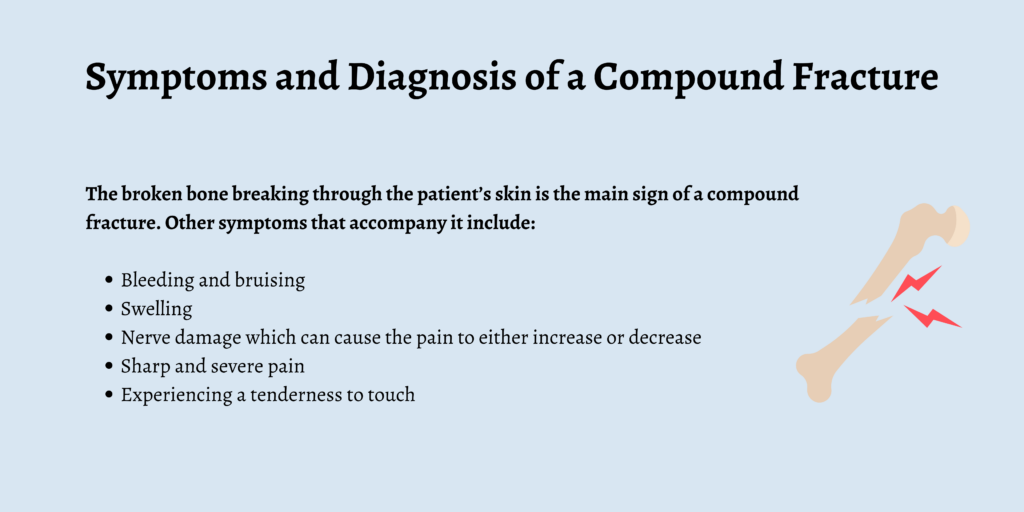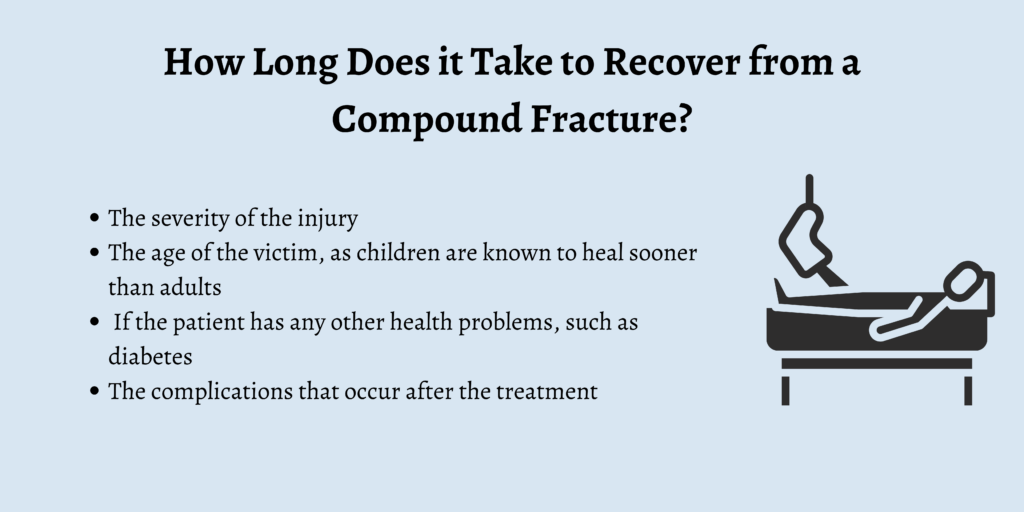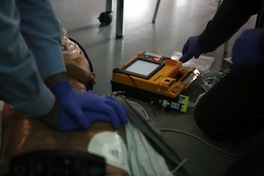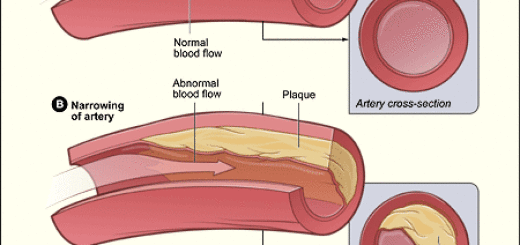What is a Compound Fracture?
A compound fracture, also known as an open fracture, this type of fracture is caused by severe trauma such as a car crash, playing contact sports like football, or falling from a great height. It mainly occurs in the limbs, such as hands, arms, feet, and legs.
Bones in the face, collarbone, and skull are less likely to experience an open fracture. A compound fracture refers to bones breaking or cracking in a way that they become visible through the skin. This occurs when the bones face force or trauma, and it can also happen due to repeated force. Unlike closed or simple fractures, which do not pierce the skin, compound fractures are called open fractures because the broken bones pierce through the victim’s skin. Treatment for compound fractures is necessary due to the severity of the injury.
Symptoms and Diagnosis of a Compound Fracture
The broken bone breaking through the patient’s skin is the main sign of a compound fracture. Other symptoms that accompany it include:
· Bleeding and bruising
· Swelling
· Nerve damage which can cause the pain to either increase or decrease
· Sharp and severe pain
· Experiencing a tenderness to touch
Once you approach a medical facility with a compound fracture, the doctor will first ask you to get a physical examination done. This will then be followed by an X-ray to check the way in which the bones are broken and how they must be aligned.
Certain tests, such as CT scans and MRIs can be ordered, too, to assess how much damage has been caused by the fracture. The doctor will check the temperature and color of the victim’s skin along with their pulse and blood pressure to ensure the bleeding isn’t significant.
Lastly, they will examine the region around the fracture and also beyond it to see if there’s any nerve damage.
First Aid Treatment For a Compound Fracture
Compound (open) fractures are at high risk of infection. In severe cases, the infection can spread into the bone itself which is a serious condition that may lead to loss of the entire limb. The infection can also lead to sepsis, a life-threatening condition caused by the immune system’s response to an infection.
Emergency medical services should always be called for any suspected open fracture.
The three main priorities when dealing with an open fracture are:
- Stop significant bleeding (hemorrhage)
- Reduce the risk of infection
- Splint / immobilize the injury
Direct pressure around the injury can stop bleeding. Alternatively, a tourniquet can be used for catastrophic bleeding from a limb.
A sterile dressing should be placed over the injury, including over any exposed bone. The limb should then be immoblized until the arrival of emergency medical services.
When is Compound Fracture Surgery Done?
Compound fractures are most commonly seen in senior citizens and athletes. Although anyone can experience it, women in the age range of 60 are more likely to experience a compound fracture in their wrists than men.
In case a child goes through a compound fracture, it’s vital their parents or guardians seek specialized care to check that the growth of the bone isn’t affected due to the accident. Such injuries can often be more severe in children since their bodies are still in the stage of growth and development.
Compound fracture surgery is required for every victim who goes through it. The P.R.I.C.E treatment is employed for this, which includes:
· Protection: Protecting the open fracture by using a wet and clean towel
· Rest: Getting enough rest so as to promote quick healing
· Ice: Using ice above the fracture and around it as well
· Compression: The fracture will be aided in healing better through a cast or similar device
· Elevation: Raising or elevating the fracture above the victim’s heart in order to reduce the swelling
Complications of a Compound Fracture
Even though a compound fracture is quite a complicated injury, not all cases lead to long-term problems. However, the complications that could arise as a result of compound fracture are as follows:
Nerve damage: Nerves can get bruised, crushed, stretched, or torn due to a compound fracture. Having mild nerve injury is also a possibility.
Shock: Compound fractures cause a lot of blood loss, which in turn can lower the blood pressure of the victim, thereby sending them into shock.
Damage to a joint: A victim’s joint could get affected if the location of the compound fracture is anywhere near it. The cartilage towards the end of the patient’s bones could get damaged, and one can also face stiffness in their joints.
Skin damage: Skin injury is inevitable when it comes to a compound fracture. The victim’s skin heals along with the broken bones and could require some extra care once the cast is removed.
Uneven limbs: The region near the ends of a person’s bones is known as the growth plate. These cause a child’s bones to grow, and if the fracture causes damage to a growth plate, it can lead to uneven limbs.
Infection: Patients can contract an infection if a strong odor comes from their cast or if they develop a fever. Immediate medical attention should be provided if this situation occurs.
Healing issues: The bones don’t always grow back together in every case. At times they either grow back in the incorrect position or slower than usual. X-rays are needed to track the progress of a victim’s healing journey, and doctors could suggest other treatments as well, if necessary.
Compartment syndrome: Compartment syndrome occurs when the pressure within a victim’s muscles amplifies to an extremely high level, thereby stopping or slowing blood flow in and out of the region.
Can a Compound Fracture be Life-threatening?
A compound fracture can be life-threatening only in very rare cases, such as if a major blood vessel gets injured due to a broken bone and is not treated immediately.
If the victim doesn’t receive immediate and proper treatment post the accident, it can cause long-term issues that are non-lethal, including bone infection.
How Long Does it Take to Recover from a Compound Fracture?
The recovery period for a compound fracture could last for several months. Factors that can affect the time required for healing include:
· The severity of the injury
· The age of the victim, as children are known to heal sooner than adults
· If the patient has any other health problems, such as diabetes
· The complications that occur after the treatment
What Happens if I Don’t Get Treatment for a Compound Fracture?
Compound fractures are extremely serious injuries and do not heal on their own. Therefore, opting for treatment is the only way to fix them. It’s imperative that the patient approaches a doctor as soon as possible since the longer they wait, the more complications there will be.
When to Seek Emergency Help for a Compound Fracture
Patients will be required to wear a cast after going through compound fracture surgery, and you should always contact your doctor if you face issues after the treatment.
These issues could be:
· The cast causes weakness or numbness
· The patient developing a fever
· The cast feels too tight, which leads to constant pain that keeps getting worse
· A strong odor emanating from the cast
FAQs
1. When does a compound fracture occur?
Compound fractures occur when a person faces trauma in the form of car accidents, playing contact sports, or falling from a significant height.
2. What are the symptoms of a compound fracture?
The symptoms of a compound fracture include the broken bone piercing the victim’s skin, bruising, swelling, bleeding, and severe pain.
3. Does compound fracture require treatment?
Yes, a compound fracture does require treatment, as it’s not something that can heal on its own.
4. What is the recovery period for a compound fracture?
It can take months to heal from a compound fracture, based on factors such as age, the severity of the injury, and the presence of other health issues.
5. How is a compound fracture diagnosed?
The diagnosis of a compound fracture includes a physical examination followed by an X-ray. It can also involve MRIs and CT scans.
Conclusion
Accidents can occur at any given time, no matter how many precautions one takes. However, one can reduce the chances of facing a compound fracture by staying away from heights, improving one’s balance and strength through yoga and other forms of exercise, and driving safely.
If you play contact sports, make sure to wear the right kind of gear and always be careful when the ground is slippery. Having the right shoes on is necessary for this purpose. By being cautious, you can save yourself from experiencing situations that lead to a compound fracture.








enlightening